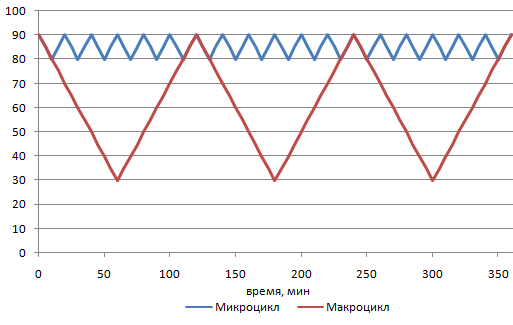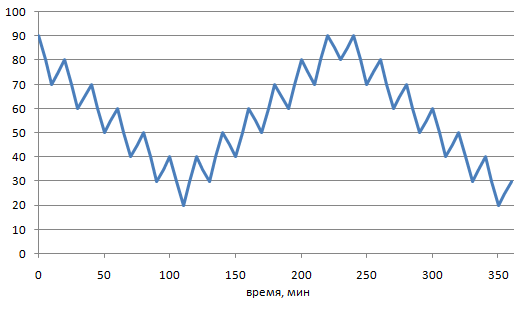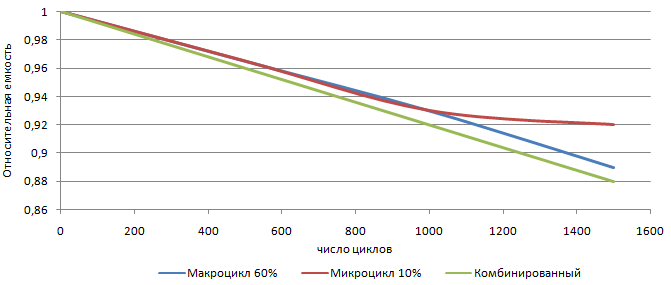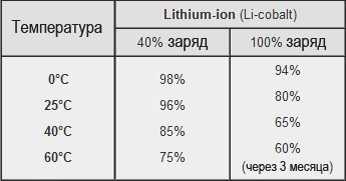Li-Ion Battery Operation
Previously, the topic was discussed in the following posts:
How to extend the life (life) of a lithium-ion battery
Why do lithium-ion batteries die so early?
5 Practical Tips for Using Lithium-Ion Batteries
Permissible temperature ranges for charging and discharging lithium-ion batteries
The following is the data obtained from the results of experiments on batteries from various manufacturers.
Tests on the number of cycles were carried out with a discharge current of 1C, for each battery were carried out cycles of discharge / charging to achieve 80% capacity. This number was chosen based on the timing of the dough and for a possible comparison of the results later. The number of full equivalent cycles is up to 7500 in some tests.
Tests for service life were carried out at various charge levels and temperatures, voltage measurements were taken every 40-50 days to monitor the discharge, the test duration was 400-500 days.
')
The main difficulty in the experiments are discrepancies in the claimed capacity and the real one. All batteries have a capacity higher than stated, from 0.1% to 5%, which introduces an additional element of unpredictability.
NCA and NMC batteries were most commonly used, but lithium-cobalt and lithium phosphate batteries were also tested.
Some terms:
DoD - Depth of Discharge - discharge depth.
SoC - State of Charge - charge level.
At the moment there is a theory that the dependence of the number of cycles that a battery can withstand on the degree of discharge of a battery in a cycle is as follows (blue indicates discharge cycles, black indicates equivalent full cycles):

This curve is called the Wöhler curve. The main idea came from the mechanics of the dependence of the number of spring tension on the degree of tension. The initial value of 3000 cycles at 100% battery discharge is a weighted average when discharging at 0.1 ° C. Some batteries show better results, some worse. At 1C, the number of full cycles at 100% discharge drops from 3000 to 1000-1500, depending on the manufacturer.
In general, this ratio, presented in the graphs, was confirmed by the results of experiments, therefore it is advisable to charge the battery whenever possible .
When batteries are used, operation is possible with the simultaneous presence of two cycles (for example, regenerative braking in a car):

It turns out the following combined cycle:

The question arises, how does this affect the operation of the battery, does the battery life significantly decrease?
According to the results of the experiments, the combined cycle showed the results as from the addition of full equivalent cycles of two independent cycles. Those. the relative capacity of the battery in the combined cycle fell, respectively, to the sum of the discharges on the small and large cycles (the linearized graph is presented below).

The effect of large discharge cycles is more significant, which means that it is better to charge the battery at every opportunity.
The memory effect of lithium-ion batteries was not observed in the experiments. In different modes, its full capacity did not change afterwards. At the same time, there are a number of works that confirm the presence of this effect in lithium phosphate and lithium-titanium batteries.
No unusual discoveries have been made here. Temperatures of 20-25 ° C are optimal (in normal life) for storing the battery , if not used. When the battery is stored at a temperature of 50 ° C, the capacity degrades almost 6 times faster.
Naturally, lower temperatures are better for storage, but in everyday life this means special cooling. Since the air temperature in the apartment is usually 20-25 ° C, then storage will most likely be at this temperature.
As tests have shown, the smaller the charge, the slower the self-discharge of the battery. The battery capacity was measured, whatever it was when it was later used after long-term storage. The best result was shown by batteries that were stored with a charge close to zero.
In general, good results were shown by batteries that were stored with no more than 60% charge level at the time of storage. The numbers differ from those below for 100% charge for the worse (i.e., the battery will become unusable earlier than indicated in the figure):

Figure taken from article 5 practical tips on how to use lithium-ion batteries
At the same time, the figures for small charges are more optimistic (94% after a year at 40 ° C for storage at a SOC of 40%).
Since 10% charge is impractical, since the operating time at this level is very small, it is optimal to store batteries at SOC 60% , which will allow to apply it at any time and will not have a critical impact on its service life.
No one has conducted tests that can be considered 100% reliable. The sample, as a rule, does not exceed a couple of thousand batteries out of millions produced. Most researchers can not provide reliable comparative analyzes for reasons of insufficient sampling. Also, the results of these experiments are often confidential information. So these recommendations do not necessarily fit your battery, but can be considered optimal.
The optimal charging frequency is at every opportunity.
Optimum storage conditions - 20-25 ° C with 60% battery charge.
1. Course "Battery Storage Systems", RWTH Aachen, Prof. Dr. rer. nat. Dirk uwe sauer
2. Memory effect in a lithium-ion battery, Tsuyoshi Sasaki, Yoshio Ukyo, Petr Novák
How to extend the life (life) of a lithium-ion battery
Why do lithium-ion batteries die so early?
5 Practical Tips for Using Lithium-Ion Batteries
Permissible temperature ranges for charging and discharging lithium-ion batteries
The following is the data obtained from the results of experiments on batteries from various manufacturers.
Testing features
Tests on the number of cycles were carried out with a discharge current of 1C, for each battery were carried out cycles of discharge / charging to achieve 80% capacity. This number was chosen based on the timing of the dough and for a possible comparison of the results later. The number of full equivalent cycles is up to 7500 in some tests.
Tests for service life were carried out at various charge levels and temperatures, voltage measurements were taken every 40-50 days to monitor the discharge, the test duration was 400-500 days.
')
The main difficulty in the experiments are discrepancies in the claimed capacity and the real one. All batteries have a capacity higher than stated, from 0.1% to 5%, which introduces an additional element of unpredictability.
NCA and NMC batteries were most commonly used, but lithium-cobalt and lithium phosphate batteries were also tested.
Some terms:
DoD - Depth of Discharge - discharge depth.
SoC - State of Charge - charge level.
Battery use
The number of cycles
At the moment there is a theory that the dependence of the number of cycles that a battery can withstand on the degree of discharge of a battery in a cycle is as follows (blue indicates discharge cycles, black indicates equivalent full cycles):

This curve is called the Wöhler curve. The main idea came from the mechanics of the dependence of the number of spring tension on the degree of tension. The initial value of 3000 cycles at 100% battery discharge is a weighted average when discharging at 0.1 ° C. Some batteries show better results, some worse. At 1C, the number of full cycles at 100% discharge drops from 3000 to 1000-1500, depending on the manufacturer.
In general, this ratio, presented in the graphs, was confirmed by the results of experiments, therefore it is advisable to charge the battery whenever possible .
Calculation of cycle superposition
When batteries are used, operation is possible with the simultaneous presence of two cycles (for example, regenerative braking in a car):

It turns out the following combined cycle:

The question arises, how does this affect the operation of the battery, does the battery life significantly decrease?
According to the results of the experiments, the combined cycle showed the results as from the addition of full equivalent cycles of two independent cycles. Those. the relative capacity of the battery in the combined cycle fell, respectively, to the sum of the discharges on the small and large cycles (the linearized graph is presented below).

The effect of large discharge cycles is more significant, which means that it is better to charge the battery at every opportunity.
Memory effect
The memory effect of lithium-ion batteries was not observed in the experiments. In different modes, its full capacity did not change afterwards. At the same time, there are a number of works that confirm the presence of this effect in lithium phosphate and lithium-titanium batteries.
Battery Storage
Storage temperatures
No unusual discoveries have been made here. Temperatures of 20-25 ° C are optimal (in normal life) for storing the battery , if not used. When the battery is stored at a temperature of 50 ° C, the capacity degrades almost 6 times faster.
Naturally, lower temperatures are better for storage, but in everyday life this means special cooling. Since the air temperature in the apartment is usually 20-25 ° C, then storage will most likely be at this temperature.
Charge level
As tests have shown, the smaller the charge, the slower the self-discharge of the battery. The battery capacity was measured, whatever it was when it was later used after long-term storage. The best result was shown by batteries that were stored with a charge close to zero.
In general, good results were shown by batteries that were stored with no more than 60% charge level at the time of storage. The numbers differ from those below for 100% charge for the worse (i.e., the battery will become unusable earlier than indicated in the figure):

Figure taken from article 5 practical tips on how to use lithium-ion batteries
At the same time, the figures for small charges are more optimistic (94% after a year at 40 ° C for storage at a SOC of 40%).
Since 10% charge is impractical, since the operating time at this level is very small, it is optimal to store batteries at SOC 60% , which will allow to apply it at any time and will not have a critical impact on its service life.
The main problems of the results of experiments
No one has conducted tests that can be considered 100% reliable. The sample, as a rule, does not exceed a couple of thousand batteries out of millions produced. Most researchers can not provide reliable comparative analyzes for reasons of insufficient sampling. Also, the results of these experiments are often confidential information. So these recommendations do not necessarily fit your battery, but can be considered optimal.
Results of the experiments
The optimal charging frequency is at every opportunity.
Optimum storage conditions - 20-25 ° C with 60% battery charge.
Sources
1. Course "Battery Storage Systems", RWTH Aachen, Prof. Dr. rer. nat. Dirk uwe sauer
2. Memory effect in a lithium-ion battery, Tsuyoshi Sasaki, Yoshio Ukyo, Petr Novák
Source: https://habr.com/ru/post/223955/
All Articles